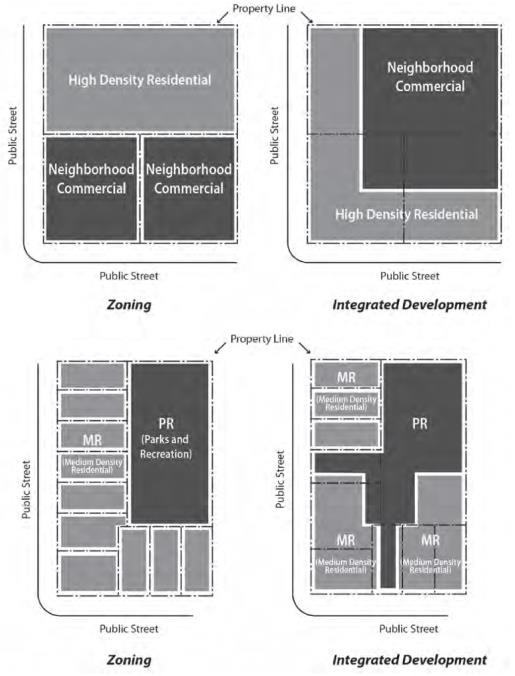Chapter 18.74
INTEGRATED DEVELOPMENT
Sections:
18.74.030 Integrated development provisions.
18.74.040 Types of integrated developments.
18.74.010 Purpose.
The purpose of this chapter is to create special regulations for projects with multiple parcels, buildings, and/or uses within a building. The intent is to encourage the integration of uses (vertically and horizontally) and to establish flexibility in the strict zoning regulations as they apply. (Ord. 738 § 1 (Exh. A) (part), 2013).
18.74.020 Applicability.
The requirements of this chapter are applicable to all residential, commercial, office, and parks and recreation districts. Integrated development may be permitted as part of a design review application and/or conditional use permit. In reviewing integrated developments, the city will analyze the combined development rights applicable to the individual subject parcels that comprise the integrated development. The development rights of each parcel are available, on an aggregate basis, to the entire integrated development. Integrated development may be applied to any base zoning district. (Ord. 738 § 1 (Exh. A) (part), 2013).
18.74.030 Integrated development provisions.
The city encourages integrated developments as a means to maximize development opportunities and to create dynamic and high quality projects throughout the community. Integrated development provisions allow the development rights of adjacent properties to be distributed throughout the development and not be limited to property or zoning lines. The intent is to provide design flexibility and promote a better integration of uses than would otherwise be available for nonintegrated or stand-alone developments. The city will also review the relationship of the uses to ensure the different pieces of the development are integrated together (e.g., pedestrian circulation and spaces, parking, lighting, access).
For example, if an integrated development includes parcels zoned neighborhood commercial (NC) and parcels zoned high density residential (HR), the corresponding development rights are not constrained to each individual parcel, respectively. Rather, the integrated development may redistribute the development rights available in the HR zone in some portion of the integrated development other than just the property(ies) zoned HR. Figure 18.74.030-1 (Examples of Integrated Development) illustrates this concept.
Figure 18.74.030-1: Examples of Integrated Development
(Ord. 738 § 1 (Exh. A) (part), 2013).
18.74.040 Types of integrated developments.
Integrated developments can be achieved in a number of ways. This section is intended to explain a variety of scenarios in which integrated developments may be considered. In all cases, the individual pieces work together to create the integrated development. Integrated developments may include a combination of developed and undeveloped parcels.
A. Common Ownership of Multiple Parcels. In instances where multiple parcels (either contiguous with shared property lines or located across the street from one another) are under the sole ownership of one party or ownership entity, a design review application may be submitted that involves all of the subject properties and as such will be considered together with respect to the design consideration and development rights.
B. Multiple Ownership of Multiple Parcels. Multiple property owners may bring forward a design review application for an integrated development where subject parcels are contiguous or are located across the street from one another. As with common ownership, the application will be considered with respect to the zoning districts of the collective properties.
C. Single Parcel with Supportive Use. A property owner may submit a design review application for a single-parcel integrated development that includes use(s) that would normally be supported within the zone but are not proposed in conjunction with a primary use (e.g., restaurant use in the MPO zone). In such instances, the city will consider a conditional use permit application on a case-by-case basis to determine if the proposed use can function as an integrated use with surrounding uses. The designated approving authority shall make the following findings:
1. That the proposed use supports the activities of the surrounding uses;
2. That the proposed use does not cause the character or overall development pattern of the area to change contrary to the development characteristics of the underlying zoning district; and
3. That the intensity of the proposed use does not create a use that is predominant within the integrated development and, as such, would otherwise require a rezoning. (Ord. 738 § 1 (Exh. A) (part), 2013).


